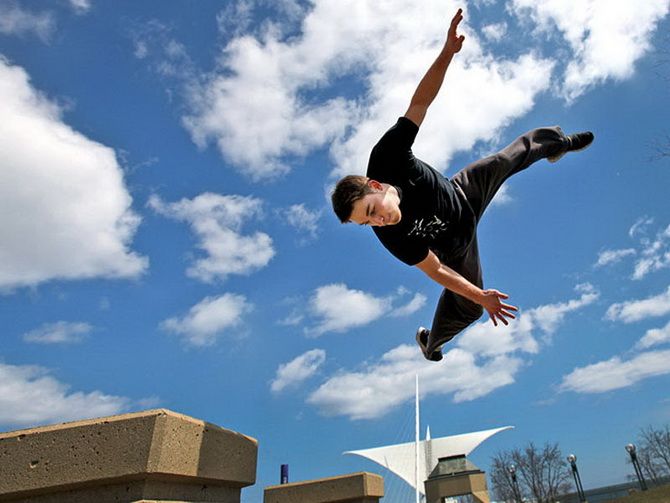If you have considered mountain climbing, rafting and skydiving to be the most extreme hobbies, forget it. There are much more dangerous hobbies, and in most cases, there isn’t much point in them, except adrenaline rush.
The editorial team of Joy-pup.com made a list of the most risky activities. Believe it or not, but the list doesn’t have any rope jumping (jumping with a rope from high-rise buildings) and bungee jumping (jumping from bridges and towers on a rubber rope). As it turned out, this is quite harmless entertainment.
1. Parkour
WHAT’S THIS: high-speed movement in urban environment with various obstacles.

The most common encyclopedic definition of parkour says that it’s a type of youth street sport, which involves rational and fastest possible movement across the city. Practitioners or tracers take it as a lifestyle.
The goal of the tracer is to reach the given point as soon as possible without using any auxiliary devices. On the way over you have to overcome fences, walls, trees, railings, jumping from roof to roof by using physical ability. Showing off and unjustified risk are not welcome: the main principles of parkour are safety, efficiency, simplicity.
However, it’s not easy at all to perform dizzying jumps, somersaults and rollings. Considerable dexterity, precise coordination of movements and physical strength is a must in this sport. There are practically no fatal cases, but fractures, bruises, torn ligaments and concussions are a fairly frequent occurrence. Despite the worldwide distribution and recognition of sports discipline, parkour can’t be called a safe sport.
2. Acrostreet
WHAT’S THIS: street acrobatics

This informal sport is often compared to parkour. This is partly true: acrosteet originated from freerun, earlier originated from parkour, which is distinguished by performance and aesthetics. The fundamental difference is that acrostreet performers don’t run anywhere: all movements are made in a limited space.
The performance looks exciting: handstand, somersaults, stunt jumps are shown right on the pavement, on concrete slabs, paving stones, asphalt or bare ground. Sportspeople wear ordinary clothes and don’t have any protective equipment. Before reaching the public, athletes train for a long time in the halls and on the sports grounds, but even well-honed skills don’t give 100 percent safety because of high injury rate
3. Planking
WHAT’S THIS: Lying face down in unexpected places

The first question that comes up is: WHY? It turns out, no reason. The whole point is to lie down on your stomach in the most inappropriate place, shoot your heroic act and post the evidence on the Internet. “Look everyone, I’m a planker!”
One might wonder, so what, you’re lying down somewhere in the supermarket, on the lawn or beneath the monument – “anything for a quiet life”. The bad thing is people choose to lie down in more dangerous places, such as busy highways, railways, escalator handrails, balcony railings or verge of the roof. No one thinks about the possible consequences of a flash mob: it’s quite the thing and therefore cool.
4. Roof climbing
WHAT’S THIS: roof walks

Roof climbing (from word roof) is not just an extreme hobby, but a way of life. Adherents of the movement are ready to walk on the roofs day and night, sit on the edge, dangling their feet over a noisy street, and take pictures of themselves against the background of urban landscapes.
Roofers take less traveled roads, they are interested in high-rise, historical or industrial buildings. The harder it is to get onto the roof, the better: it’s always cool to break open the lock, knock out the door, and drop the attic window. It’s not surprising that such activities often lead to the police station.
In addition, some people “chase after” adrenalin: they balance on a narrow fence and demonstrate acrobatic exercise at a dizzying height. Although the authorities of many countries see some suicidal tendencies in this quite harmful occupation and try to ban it at the legislative level, the number of roof climbing adherents is constantly growing. Most of them are high school students and students.
5. Sky walking
WHAT’S THIS: rising to the highest points of the city without belaying

This extreme sport is called sky walking. It could develop as the next even more dangerous stage of roof climbing. The goal is to conquer the highest urban “peaks” like television towers, skyscrapers, towers, and bridges without any equipment.
According to skyway lovers, they are attracted by the feeling of uncontrolled freedom and, of course, by the ability to make spectacular shots. The high-end pleasure is to hang above the steep, holding the spire, the edge of the roof or the bridge railing with one hand, t or the railing of the bridge. But … one awkward move can cost a life.
6. Train hitching
WHAT’S THIS: act of hitching a ride on the outside of a moving train, tram or subway
This extreme hobby is also called train surfing or train hopping. It’s a free movement on trains and other types of rail transport. It is believed that it originated from the very advent of the railroads, and in the war and post-war years was even due to objective necessity: there were simply not enough place in crowded trains.
However, such deadly trains still run in India. The locals sit on rooftops or hang on the outside, which inevitably kills 8-10 people a day.
Sometimes people travel outside wagons because they don’t want to pay for tickets, but more often for kicks. Reckless teenagers cling to handrails and bars, climb onto the steps and inter-car gangways, settle on buffers and other protruding parts.
Professionals (there are some) use special equipment: safety belts, locking carbines, vacuum culling, protective masks. Unfortunately there are much more amateurs, who fall down from moving trains, hit the poles and tunnel consoles, die from touching high-voltage tires and fall under the wheels.
7. Basejumping
WHAT’S THIS: free fall with a parachute

Compared to this extreme activity, skydiving is an innocent child’s play. The main distinction of the jump is a relatively small height, about 150-200 meters. For reference: an ordinary parachute must break out at a height of not lower than 600 meters, otherwise the athlete will break his legs (in a best-case scenario).
But there is more! Base jumpers (or basers) jump from steep cliffs, high-rise buildings, antennas, towers, bridges, in other words, from nonmoving objects. This is not just dangerous, but deathful caused by numerous risks. Something can go wrong with a parachute, the person can hit something or land unsuccessfully. Special clothing is provided, but there is no safety equipment: a reserve parachute simply does not make sense. Every base jump is a death game. The BASE Fatality List page has been created on the Internet, where a list of dead basers is managed. It has 381 people by now
Our life is quite boring, isn’t it? However, it is not necessary to risk your life, because there are a lot of other interesting and unusual hobbies in the world.
Photo for the article: © angela_nikolau / Instagram






Only registered users can leave comments